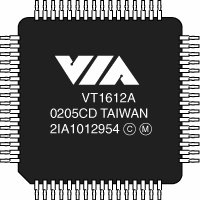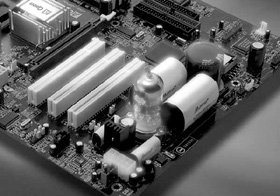Who s Who in Audio
Who's Who in AudioBecause audio adapters have become common features in systems, many vendors have produced audio adapters, audio chips, integrated motherboard chipsets with audio features, and even specialized vacuum tube audio. This section examines some of these companies and their products. As you've learned in other chapters, I believe it is very important to get all the technical information you can about your computer and its components. By knowing who makes the audio chip your computer depends on, you can find out what the hardware can do and be better able to find upgrades to the software drivers you need to get the most out of your audio hardware. Chipset Makers Who Make Their Own Audio AdaptersJust as graphics card vendors are divided into two camps, chipset makers are divided into these two categories:
Audio adapter vendors fall into the same categories. One of the pioneers of the audio adapter business, Creative (formerly known as Creative Labs), has also been among the leaders in developing audio chips. Creative develops audio chips primarily for its own Sound Blasterbranded products, but it has sold some of its older Sound Blaster 16 products into OEM markets. Creative's major audio chips have included the following:
Various other companies have produced their own sound chips in the past but no longer do so. The primary makers that fit in this category are
Should you panic if your favorite audio adapter is an "orphan?" Not necessarily. If the audio adapter vendor provides good technical support and up-to-date drivers, you're okay for now. But, the next time an operating system update or new audio API shows up, you probably won't be able to take advantage of it unless you replace your audio adapter. Major Sound Chip MakersMost companies other than Creative depend on third parties to make their audio chips. Some of the major vendors include Aztech; Cirrus Logic/Crystal Semiconductor; ESS Technology; C-Media Electronics; ForteMedia, Inc.; and VIA Technologies. Discontinued and Orphan Sound Chips and Sound Card ProducersThe following sound chips are no longer being sold, and ongoing support is limited or no longer available. If you use an audio adapter based on one of these products, you might need to upgrade if you can't get drivers for new and forthcoming operating systems. Discontinued products include
Note The former Diamond Multimedia division of S3 (later Sonic Blue, now out of business) sold sound cards using chips from various vendors, including ESS Technology, Aureala, and others. The current Diamond Multimedia product line of graphics cards and modems is sold and supported by Best Data Products. Motherboard Chipsets with Integrated AudioThe Intel 810 chipset was the first mainstream chipset for a major CPU to integrate audio; it works with Celeron CPUs. Its inspiration might have been the Cyrix/National Semiconductor Media GX series, which used a trio of chips to substitute for the CPU, VGA video, onboard audio, memory, and I/O tasks. Thanks to improvements in chipset design and faster CPU performance, today's best integrated chipsets can provide solid mid-range performance. Almost all recent chipsets from Intel, VIA, ALi, and SiS have integrated audio (see Chapter 4, "Motherboards and Buses," for details). In almost every case, integrated audio supports the AC'97 audio standard. AC'97 Integrated AudioThe phrase AC'97 integrated audio can be found in the descriptions of most recent systems. Because AC'97 can replace the need for a separate audio card but might not be a satisfactory replacement, you need to understand what it is and how it works. AC'97 (often referred to as AC97) is an Intel specification that connects an audio codec (compression/decompression) architecture to a section of a South Bridge, an I/O Communications Hub chip called the AC-Link control, or an audio controller such as the VIA Envy24 series. The AC-Link control works with the CPU and an AC'97 digital signal processor (DSP) to create audio. The AC'97 audio codec could be a physical chip on the motherboard, a chip on a small daughterboard called a communications and networking riser (CNR), or a software program. Thus, a motherboard with AC'97 integrated sound support doesn't require the use of a separate audio card for sound playback. Sometimes AC'97 is also used to refer to audio chips on a sound card, but in this discussion we will use it to refer only to integrated audio. Sometimes motherboards also integrate an analog modem through an MC '97 codec chip, or they might have an AMC '97 (audio/modem) codec chip to combine both functions. Note Some low-cost sound cards and some USB-based audio products use AC'97 codec chips along with additional components instead of traditional single-chip audio solutions. It's important to realize that, although most recent chipsets support AC'97 audio, this does not mean that every motherboard built on a particular chipset uses the same AC'97 codec, or even the same method of creating sound. In most cases, AC'97 is implemented through a small AC'97 codec chip on the motherboard (see Figure 14.8). It can be surface-mounted as shown in Figure 14.8, but many vendors use a small socket instead. Figure 14.8. The VIA VT1612A is a typical AC'97 2.2compliant codec chip. Photo courtesy of VIA Technologies, Inc. A few motherboards use an AMR or a CNR riser card to implement AC'97 audio along with audio ports. For various reasons, including audio codec features and price, different motherboard vendors might use different AC'97 codec chips on motherboards that use the same chipset. For example, compare the following motherboards based on the Intel 865PE chipsets as listed in Table 14.5.
Major vendors of AC'97 codecs include Analog Devices (SoundMAX), C-Media, Cirrus Logic (Crystal Audio), National Semiconductor, Realtek (includes former Avance Logic products), SigmaTel (STAC C-Major), VIA Technologies, and Wolfson Microelectronics plc. Note The drivers for a particular AC'97 codec chip are supplied by your motherboard vendor because they must be customized to the combination of codec and South Bridge/ICH chip your motherboard uses. Although the AC'97 specification recommends a standard pinout, differences do exist between AC'97 codec chips. Some vendors of AC'97 chips provide technical information to help motherboard builders design sockets that can be used with different models of the AC'97 codec chip. However, in other cases, AC'97 codecs are surface-mounted to the motherboard. The four versions of the AC'97 codec are as follows:
Note Intel released Intel High Definition Audio in 2004 for delivering high-definition audio capable of playing back more channels at higher quality than AC'97 integrated audio formats. The hardware based on Intel HD Audio specifications is capable of delivering 192KHz/32-bit quality for eight channels. Note Audio solutions that use AC'97 2.3compliant codecs can detect whether you have connected a speaker to the microphone jack or a microphone to the speaker jack and warn you that the wrong jack is being used for the device. This helps eliminate one of the most common causes of audio failures. Most recent motherboards with integrated audio support AC'97 2.2 or 2.3. To learn more about the AC'97 specifications, see the Intel Research and Development, Audio Codec site at www.intel.com/design/chipsets/audio/. To determine whether a particular motherboard's implementation of AC'97 audio will be satisfactory, follow these steps:
A Open TubeSoundThe Taiwan-based motherboard maker AOpen, part of the Acer Group, came up with a very interesting gimmick in June 2002 when it introduced the world's first PC motherboard with a vacuum tubebased audio amplifierthe AOpen AX4B-533 Tube. Although, the motherboard, which was based on the Intel 845E chipset and uses a Realtek ALC650 AC'97 audio codec chip, is no longer a current product, its unique design is still worth noting here. At first, many PC users wondered whether this was an April Fool's joke that showed up late. Why a vacuum tube? AOpen engineers pointed out that serious audio-philes have continued to use vacuum-tube amplifiers because of their rich sound. They felt that audio-philes would pay a premium price for similar technology in the sound circuitry of a PC. AOpen used the following design features to bring the vacuum tube into the twenty-first century:
The additional circuitry used by the AX4B-533 Tube made it one of the most expensive motherboards using the 845E chipset (see Figure 14.9). However, it has received rave reviews from many computer publications and users for audio quality, performance, and (not least) the snob appeal of having the first motherboard on the block like it. Figure 14.9. A close look at the A4XB-533's vacuum tube sound system. The AX4B-533 Tube's audio quality is optimized for classical and jazz music listening. AOpen has now released additional vacuum-tube-based motherboards: the AX4GE Tube and AX4PE Tube for Pentium 4 processors and the AK79G Tube for Athlon XP processors. These motherboards are optimized for rock and pop music thanks to a slightly revised tube and amplifier design. Tip To compare these motherboards in more detail, see the AOpen TubeSound technology website at http://usa.aopen.com/tech/techinside/Tube.htm. |
EAN: 2147483647
Pages: 283

